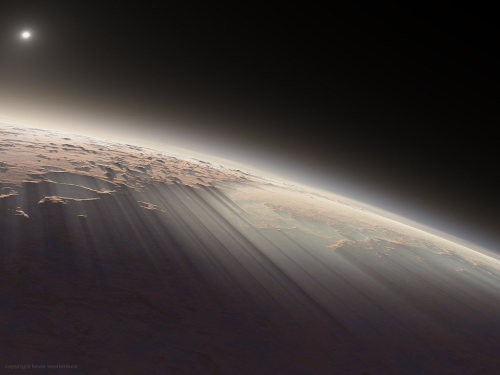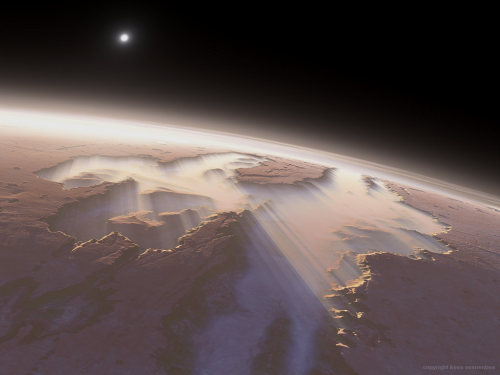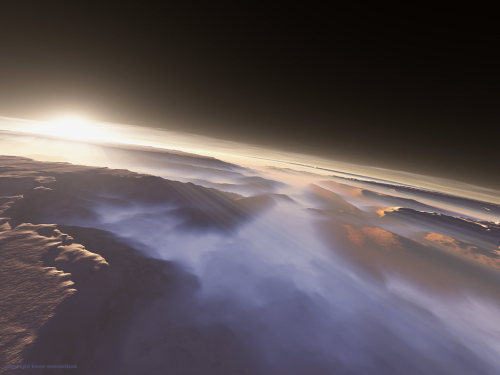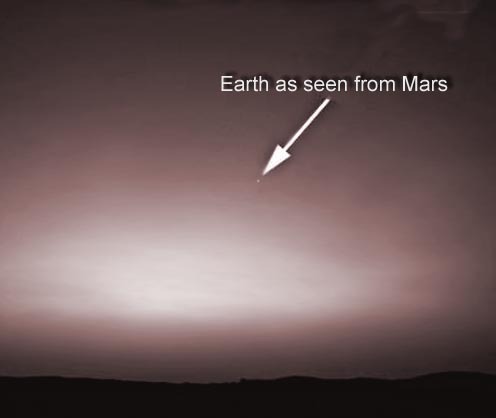Mars - Blog Posts
MarCO Media Reel
CosmoCorps BONUS! MARS Curiosity Panoramic Vision!
Mars Panorama - Curiosity rover: Martian solar day 437 in The World
=^.^= https://rebelmouse.com/CosmoCorps/
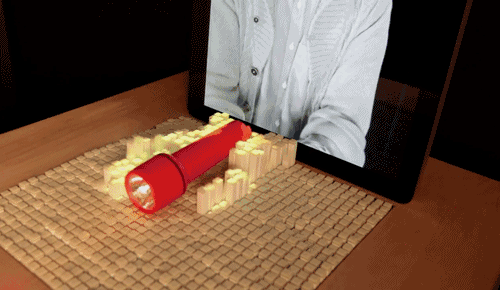
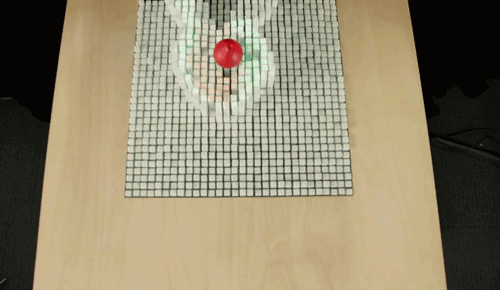
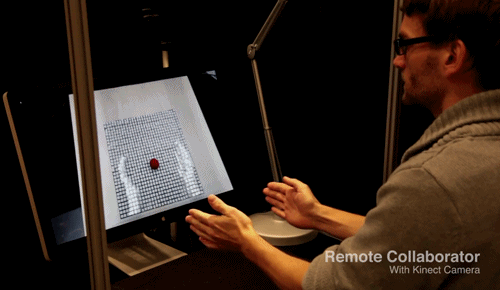
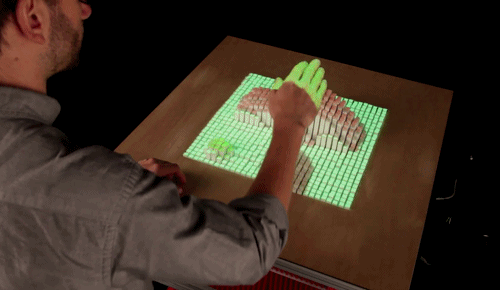
inForm
Incredibly impressive interactive dynamic display which demonstrates potential possibilities working with adaptive form both locally and remotely - video embedded below:
inFORM is a Dynamic Shape Display that can render 3D content physically, so users can interact with digital information in a tangible way. inFORM can also interact with the physical world around it, for example moving objects on the table’s surface. Remote participants in a video conference can be displayed physically, allowing for a strong sense of presence and the ability to interact physically at a distance. inFORM is a step toward our vision of Radical Atoms: tangible.media.mit.edu/vision/
tangible.media.mit.edu/project/inform/
More Here

As of now Starship is now the largest rocket ever made!!
LOL oh @claraxbarton you know me SO well!
I’ve totally got the first ep on my DVR - I just haven’t had time to watch it lol
@maevemauvaise !!!!!!!!!!!!

NASA Meets Super Bowl LI
Super Bowl has taken over Houston and NASA! VIPs have been touring all week with cameras flashing and film rolling. Despite the excitement work at Johnson continues uninterrupted. During work hours we are the entertainment viewed by the VIPs as we test, train and support space missions. In fact, today I conducted user testing in the Space Vehicle Mock Up Facility, a facility that feels like a fish bowl as tour goers check out Space Station and Orion training mock-ups. Heads down and clip boards out we user tested a device for on board International Space Station. However, last week NASA put together an opportunity to meet retired NFL players during lunch to get our Super Bowl fill before the big week.

NASA has a huge presence at Super Bowl events and is expected to be featured during on the big screen during pre-game shows and game. There has been film crews running around Johnson and other related centers, I will be watching for some NASA love on TV Sunday! Here is a TV Guide of when coverage will start for those who don't get a newspaper: http://www.tvguide.com/listings/ The Fox Super Bowl Kick Off starts at 12:00pmCT Noon and the game starts at 5:30pmCT. Already NASA has taken over downtown Houston with the Orion Capsule, space booths and a giant drop tower that virtually send you to Mars and back. NASA has also made a number of Super Bowl related videos and social media posts found below...

NASA Referees Test of Footballs vs. Webb Telescope ^

Referee Robonaut: Robot Preforms Football Signals^

NASA Team! Where innovation meets sports.^

Journalists and bloggers attend NASA Social to ask astronauts about SuperBowl related questions. ^

Yahoo's Tony Sirusa rides in the Modular Robotic Vehicle^
Enjoy the game Sunday!






Throwback to when I captained a FIRST Robotics team and a really fun interview about my NASA Co-Op experience:
http://www.fox21online.com/news/local-news/UMD-Student-Reaches-For-The-Stars-With-NASA/42581116

Since over $20k was raised for space camp scholarships, students can APPLY NOW for a full ride to space camp! This was a result of The Martian novel themed Potato Challenge fundraiser on Minnesota Give to the Max day: http://themarsgeneration.org/scholarships/



Successful Potato Challenge and Minnesota Give to the Max day fundraising for student space camp scholarships. After 24 hours of potatoes, over $10,000 was raised reaching the goal to receive an additional $10,000 donation match! Wow, that's a lot of education! Learn more about The Mars Generation who kicked off this effort: http://themarsgeneration.org

Potato Challenge
When: Thursday November 17th
What: 24 hrs... 12 oz of water... 10 medium potatoes... awesome prizes!
Who: You! Click here to sign up.

Why?? The purpose of eating only potatoes is to raise money to fund scholarships so kids can go to space camp! The potatoes of course is in honor of Mark Watney, from The Martian book by Andy Weir, who survived on Mars by eating mostly potatoes grown in his and his friends’ feces. This fundraiser is a part of the larger “Give to the Max Minnesota Day” Nov 17th, when local groups strive to raise awareness and money.
Details: Depending on how much money is raised you can add toppings and have other snacks. As of the time of posting you can’t even put salt or pepper on your potatoes! Here is the dollar amount vs topping chart and prize details.
Donate: Click here to give money for kids’ space camp scholarships.


Sensing Mars: NASA Co-Op #2 Week Nine
Running trials with the new humidity on my fluid rig showed the fruits of my labor finally ripened. This week I ran three trials to collect data determining if a small business designed Humidity Sensor makes accurate measurements. NASA collaborates with small businesses to solve problems related to upcoming missions. The small business designed this Humidity Sensor so it could measure the humidity on Mars without corroding due to the planet’s chemistry.

Using sensors that NASA is familiar with I ran trial cases to get three different data points and compared those measurements to the new sensor. I created a low humidity environment with a desiccant (drier), created a moderate humidity with ambient air and a high humidity environment with a water bubbler. Using a National Instruments cDAQ (compact data acquisition) I collected data from a thermocouple, pressure gauge and a Vaisala humidity sensor that measures dew point (the temperature at which air can no longer “hold” all of the water vapor which is mixed with it) and mixing ratio (mass of water vapor over the mass of dry air). The new humidity sensor simply gives me the parts per million (ppm) of water using it’s ultrasensitive laser absorption spectroscopy. My other sensors don’t give me a ppm value so I have to calculate it using equations from my mentors “Fundamentals of Engineering Thermodynamics” book.

Building this trial rig was a unique experience because it required knowledge in electronics to interpret the signals sent by the sensors, computer science to write the data acquisition program and VNC (Virtual Network Computing) and chemical engineering to interpret data reported and use correct thermodynamics principles and equations. Next week will be looking at the data and get tangible values about how accurate the new Humidity Sensor is.

WAYS TO GET INVOLVED
Check out the AstrOlympics
See what NASA was up to this week
Apply for a NASA Co-Op
Apply for a NASA Internship

I had the awesome opportunity to have coffee with Johnson Space Center (JSC) Director Ellen Ochoa and Deputy Director Mark Geyer. Above I am pictured to the left of Ochoa in a red blazer and I look pretty serious writing notes. JSC leaders have been striving to hear voices from employees up high, in the trenches, wise, and new. Recently JSC Center and Deputy Directors have hosted coffees to share their goals for JSC and listen to concerns. Ochoa and Geyer shared their vision of JSC 2.016, how NASA can do more with less resources and deliver what is expected and beyond on current missions. Out of all NASA contractors and civil servants I was randomly selected to share my perspective and concerns as a Co-Op.
JSC 2.016
It's no secret that NASA's budget is far less than it was during the Apollo Era. NASA's budget was over 4% of the federal budget during the Space Race to the Moon and now below 1% despite NASA's goals to journey to Mars. Keeping realistic in funds and resources JSC 2.016 is a mantra adopted by NASA employees to do more with the resources they have. At the coffee Ochoa shared that the goals of JSC 2.016 is to ensure our work is pushing forward NASA's current missions, enabling change by listening to and adopting new ideas, removing obstacles that hinder progress, and share NASA's missions with communities.

Concerns
Before attending the coffee I polled JSC interns and Co-Ops to see if they had concerns and questions to share. Within moments of the coffee starting Ochoa and Geyer shared essential insights on how NASA’s mission is evolving in a five, ten and beyond year sense - it was very Carl Sagan Cosmos-esk. Once I was brought to this level of long-term thinking my key concern broadened from specifics. During my opportunity to talk I mentioned the concern about the vagueness of the Journey to Mars mission compared to the solidity of Space Launch System, Orion, Space Station and Commercial Crew missions. I was surprised to hear that fluidity of our Journey to Mars is actually intended. Discoveries and knowledge from Space Launch System, Orion, Space Station and Commercial Crew missions are necessary before solidifying the Journey to Mars. During those missions we will collect a lot of data on the vehicles that will be carrying our astronauts, learn new things we didn’t plan to learn and test the waters with deep space collaboration with private industries and international partners. Fluidity is the nature of NASA’s long-term impact on humanity which is unique to all other forces in the world advocating for short term instant gratification (short term can even mean one year, eight years and even decades compared to humanity as a whole). NASA must deliver what is expected of us and beyond on these current solid missions to ensure more solidified Mars related mission in the future.
We Still Need NASA
With all the SpaceX, Lockheed Martin and general private space industry hype some may have the impression that we no longer need NASA for space exploration. Articles titled "U.S. government should fund private space companies, not NASA" paint false claims of competition between government space missions and private industry. During this coffee this misconception of competition was expunged and I was re-energized about why we still need NASA. NASA, as a subset of the US Government, awards contracts to private space companies that would otherwise not be able to pursue these aerospace endeavors because they do not bring in a profit. The government can risk to make these long-term investments without certainty of short-term instant gratification like profit. There is a tendency to forget that NASA has been contracting work to private companies since the 1960s. Grumman Aircraft was contracted to build the Lunar Excursion Module (LEM) in 1962. Being a government agency, NASA can foster a unique relationship between other countries space agencies such as ROSCOSMOS, JAXA and ESA. Through decades NASA is the government agency that has lead the cohesiveness and steady beat of the drum of space exploration progress.

Fellow Co-Op shared her experience testing Curiosity Rover's drill, Morpheous tested thrusters and students toured space structure labs.
Jackelynne Silva-Martinez presented "Behind the Scenes on the Verification and Validation (V&V) Tests of the Curiosity Rover's Robotic Arm." The Curiosity rover has been gathering data on Mars since August 2012. Jacky is a mechanical engineer who was a test operator for the MSL robotic arm during its V&V surface tests for sample acquisition, processing and handling. She tested with equipment which are a replica of the drill and the Collection and Handling for In situ Martian Rock Analysis (CHIMRA).

Engineering Structures (ES) students hosted a presentation and tour of labs that they work in for fellow Co-Ops and interns. These ES students are working on testing materials that cover Orion, untangling vibrations the Space Launch System experiences during tests and analyzing samples after the first Orion test.

ES had lab with electron microscopes, impact test tools and a 3D printing lab. From the outside the ES building looks like a bunch of office spaces but nested in the inside are many we equipped labs.

July 20th was the Moon Landing's 47th anniversary. In celebration Johnson Space hosted an ice-cream party!

Morpheus is a planetary lander capable of taking off vertically. This week Morpheus' positioning thrusters were tested to capture footage for Engineering Propulsion. The test happened outside and we had to stay in the lab to remotely operate the test. Co-Op Michael O'Donnell is working on Morpheus preparing it's fuel chambers for thermo testing.











43 Acres of Aerospace: NASA Co-Op #2 Week Five & Six
If you think NASA is dead then you have probably never personally visited a NASA Center. 27 Johnson Space students had the awesome opportunity to tour the Michoud (Meh-shood) Assembly Facility. Here the Space Launch System (SLS), largest rocket in the world with 20% more thrust than Saturn V, is being built. SLS will send an unmanned Orion Space Craft around the Moon in Fall of 2018. In the history of spaceflight unmanned missions are common to ensure astronauts will be safe. The 43 acre indoor assembly facility is so large you have to ride a tram indoors for a tour. We saw liquid nitrogen tanks, liquid oxygen tanks, rings, domes and all the tools to safely weld/ fasten these parts together. Employees could be seen in hard hats and florescent yellow vests monitoring the tank's construction and creation of parts.
North of Michoud is Stennis Space Center, masters of engine tests and keeper of partners across the US Government. Buildings dedicated to work done by the Navy, National Oceanic and Atmospheric Administration, Universities and US Geological Survey for maximum collaboration. Stennis is unique because it is surrounded by a 125,000 acre acoustical buffer zone comprised of local trees. Despite buffer efforts past tests have been known to shatter windows! We were scheduled to see an engine test at test stand A above but we unfortunately missed due to engine technical difficulties. Aerospace engineering is hard guys, I'm glad they are doing what they got to do to ensure a successful mission.
I encourage you to visit a NASA center and take a tour of the facilities offered by the respective center's visitor centers. See for your self the progress toward our journey to mars. Johnson Space offers a tram tour to Mission Control, Mock Up Facility and the Shuttle Systems Test Facility. I am sure other centers offer similar opportunities. NASA visitor centers can be found here.






Space Launch System (SLS) booster test screen shots from today. This booster uses 5.5 tons of propellent a second! The booster will help sling shot an unmanned Orion Space Craft around the Moon in late 2018. In mid July I will going to a SLS engine test in person.




Mars Dust into Thrust: NASA Co-Op #2 Week One
You would think pursuing a double major in electrical engineering and computer science would provide enough breadth to remain confident at a Co-Op... wrong. As I start my second Co-Op tour at NASA Johnson's Propulsion & Energy Conversion team I am finding that the more you learn the less you know. This summer I will be LabVIEW programming for In Situ Resource Utilization (ISRU) a system that turns Mars dust into fuel. ISRU is a rover payload that takes in mars atmosphere and soil and turns it into liquid methane and oxygen (fuel options). Other capabilities is getting O2 to breathe and excavating drinkable water. One of my projects is to control with a National Instruments compact cRIO an oxygen liquefier and a new water concentration sensor. The sensor I am testing uses spectroscopy to eliminate sensor erosion from corrosive Mars materials. These tasks are very chemical engineering heavy which require understanding a system and how to control it safely. I am excited to tackle this learning curve, understand more about Mars mission energy systems, and become more comfortable with chemical engineering concepts. WAYS TO GET INVOLVED Watch what NASA is up to: https://youtu.be/p_snvjghMJg Learn how to program with LabVIEW: https://youtu.be/IOkoyuikj5Q?list=PLdNp0fxltzmPvvK_yjX-XyYgfVW8WK4tu Read about our journey to Mars: http://www.nasa.gov/topics/journeytomars/index.html ISRU in more depth: https://youtu.be/M3HbD1S_H5U
One of my NASA mentors worked on BEAM. It's nuts to see something go from testing to orbit! #journeytomars





NASA Co-Op Week 12: Makers & 3D Printers
Well-being of a generation can be measured by the number of children who attend a Maker Faire. Houston's George R Brown Convention Center was filled with programmers, 3D printers,hand made creations, geeky gear and folks passionate about their ability to create. Houston Maker Faire featured 150 booths, soap makers, FIRST/ VEX robotics teams, LEGO builders and cosplay costume makers. Us NASA interns and Co-Ops set up a booth sharing about career opportunities, letting students share ideas with NASA and coloring pages with kids. Folks tried on an Apollo 11 helmet and space walk glove.
WAYS TO GET INVOLVED
Apply for a NASA internship open now, login to apply. Sooner the better. There are also fellowships and scholarships available: https://intern.nasa.gov/ossi/web/students/login/
Mentor a FIRST Robotics team. Teams with students age K-12:
http://www.usfirst.org/roboticsprograms/coachesmentors
Apply to be a NASA Community College Aerospace Scholar open now: https://nas.okstate.edu/ncas/
Activity sheets for students: http://www.nasa.gov/centers/johnson/about/resources/jscfacts/activity_coloring_sheets.html
Co-Op for NASA. What does this mean? Flip-flop between working at NASA and studying in college. This is how NASA hires a majority of their Civil Servants. Job openings are updated every week or so: http://nasajobs.nasa.gov/studentopps/employment/opportunities.htm
Accomplishments this week at NASA: https://youtu.be/4iaScOqvI64
Full-time positions at NASA. Use this website and simply search "NASA": https://www.usajobs.gov/





NASA National Community College Aerospace Scholars Fellow interns did an amazing job mentoring NASA's National Community College Aerospace Scholars (NCAS). They held a panel sharing their NASA stories as NCAS alumni sharing wisdom about treating rejection like an opportunity, achieving excellence over perfection, fundraising no matter what, and following your passion. The NCAS students built autonomous Lego robots that retrieved pieces of rovers from a mock Mars surface. You too can be a part of NCAS Due Early December 2015: https://nas.okstate.edu/ncas/







NASA Co-Op Week 7: Astronaut, Rovers & Robots
One wheel off the edge of a cliff ten of us were jam packed in a rover sweating like dogs.
Robonaut, Valkyrie, Modular Robotic Vehicle and Small Pressurized Rover are the electrical explorers we visited during a Johnson Space Center robotics tour. Waiting in NASA's Rock Yard was a speedy electric vehicle and a crater climbing rover. MRV is an electric drive vehicle that is has high maneuverability that would score big in drifting competitions. We all got to ride in the Small Pressurized Rover which wasn't really small at all. This giant monster truck looking rover took us in and out of lunar like creators and up a steep Mars like hill. The operator drove us to the edge of the hill and asked, "All right, are you ready to go down?" Grasping to our seats we were all white knuckled. Backing up the rover the operator laughed, "Going down that hill would have wrecked the vehicle". For those few seconds the inside of the rover became even more sauna like. In The Martian movie you will see a modified version of the Small Pressurized Rover that Mark Watney drives around.
Robotnaut is the humanoid robot you see on the news all the time that works in the International Space Station (ISS). Flexing muscles and articulating fingers Robotnaut showed off for us. Robotnaut is very strong able to lift over 20lb of weight in manners that would make arm day miserable. However, Robotnaut is also very delicate able to sense the wight of a nickle on its fingertips.
Valkyrie is a full bodied humanoid robot designed to perform human tasks in conditions unsafe for humans. The idea for Valkyrie came after the Fukushima Accident where more damage could have been avoided if valves were closed near the site, a task a robot could do. Valkyrie is also being designed for low gravity exploration like Mars or Lunar exploration.
Astronaut Michael Fossum talked us student this week too. He flew two Shuttle Missions and a six month long mission to the International Space Station. Before he was in space Fossum engineered ways to repair the shuttle during space walks to prevent any pieces from breaking off. During the space walk Fossum navigated over to the tiles on the space station and sealed spaces and breaks with cocking substance. He mentioned when you look "down" in various directions during a spacewalk you can either see the surface of Earth or a black nothingness. Fossum also was the first to capture a time-lapse of Northern Light and the first astronaut to operate Robotnaut on the ISS.
HOW TO GET INVOLVED
Read about the Small Pressurized Rover and its future missions
Learn about Valkyrie's future endeavors
Watch Astronaut Mike Fossum operate Robotnaut
Robotnaut's younger sibling Robotnaut2 operating switches on the ISS
Human like hand motions by Robonaut2
Start your career with NASA and tune into a Virtual Career Fair and hear about internship, fellowships and scholarships October 8th 12pm-3:30pmCT





NASA Intern Reviews The Martian Movie
Maybe I am biased saying that The Martian is a must see, inspiring, stellar movie because I eat, sleep and defecate space exploration. However I am not here to tell you how great it was cinematically but answer some questions folks are curious about. As a NASA intern can you share some of the accuracies and inaccuracies of The Martain? Understand that many from the space community hang up their lab coats before walking into the theater. With my unhealthy space obsession I was wearing my lab coat complete with googles and a pocket protector.
Dust Storm Astronauts of the Ares III mission are caught in a dust storm so fierce they are forced to scrub the mission and return to Earth early. This catastrophic events sounds socking leaving people to wonder, why would we want to explore such a hostile planet? Fortunately the scenario of a powerful dust storm is not possible due to Mars’ thin atmosphere, 100 times thinner than Earth’s. Mars does indeed have dust storms, in fact the largest dust storms in our solar system, they could not however knock anyone over. Author Andy Weir was aware of the inaccuracy even thinking of alternate openings but ultimately stuck with the dust storm opening.
Suiting Up Valiantly Mark Watney and the other astronauts quickly suited up to abort, perform tasks, or save a friend. The suits that are currently being used on board the International Space Station take around 15 minutes to don. Before astronauts perform Extra Vehicular Activities (EVAs), like a space walk, they start testing and preparing suit a day before. Some activies the astronauts must perform to prep for an EVA include; Pre-breathe 100 percent oxygen for 30 minutes to remove nitrogen from their blood and tissue, Rub the helmet with anti-fog compound, Insert a food bar and water-filled bag, and Check the suit for leaks by increasing the pressure to 0.20 atm above the airlock pressure. Maybe the models of space suits in The Martian have advanced greatly and take seconds to put on. Today’s astronauts would sure be jealous.
Banter Joking between the crew members and sarcasm between NASA members was accurate. Performing missions can get stressful and comments like the astronauts made between each other during Mars rock excavation occurs to relieve tension. But sometimes astronauts simply have a sense of humor. I’m glad The Martian portrayed the human side of NASA.
Mission Control Portrayed as a dimly lit stock exchange room futuristic Johnson Space Center (JSC) Mission Control Center contains dozens of consoles where flight controllers operate mission from. The first big no no is housing employees responsible for critical dynamic troubleshooting in a dark sleepy room. Cinematically it made the labels for the various consoles Flight Director, CAPCOM, ADCO look really cool. Yes, the mission control center in JSC has cool light-up blue console name plates. A second no no is the high number of consoles filling the big room. A flight director would have problems communicating with such a large group especially while systems were failing.
I understand that so many positions in mission control were added to operate the new technologies needed to complete the Mars mission and I thought of a solution. Currently at JSC our front room mission control (FCR, pronounced “ficker”) is what everyone sees on TV with the iconic consoles and big displays. Behind the scenes the Multi-Purpose Support Room (MPSR, pronounced “mipser”) controllers troubleshoot issues and work on procedures as well. MPSRs could reduce the number of consoles needed for a Mars mission. MPSR controllers can still communicate their concerns on audio loops to their FCR leaders.
NASA Family Everyone was cheering to save Mark Watney and bring him home. NASA scientists, engineers, leaders, and the whole community came together working overtime to keep him alive. This sense of “NASA Family” is very real at NASA and is a state of community that you feel even after a few weeks onsite. During Apollo 13 you could sense everyone’s held breath and relief when they returned safely. You could feel a heavy weight and sorrow after the Columbia and Challenger disasters. Pride was presented boldly with waving flags, hugs and cheering after the Moon landing. NASA is a family innovating for the future and striving for more moments to cheer about.
Little Catches *Good the time delay in communication between Mars and Earth was accurately explained. *Why was that astrophysicist wearing a heavy coat at Jet Propulsion Laboratory in California and Johnson Space Center in Texas? *Our NASA Centers do not yet look that pristine, in fact a lot of them contain asbestos.
Sources My experience and… https://youtu.be/m2bkJQah_dE http://science.howstuffworks.com/space-suit6.htm http://stao.ca/gr6space/livinginspace/Donning%20a%20spacesuit%20_article.pdf http://www.space.com/16903-mars-atmosphere-climate-weather.html





NASA Co-Op Week 4: Meeting Martians
Stars from the Martian movie visited Johnson Space Center including Sebastian Stan (who plays an astronaut and was also the Winter Solider in an Avengers Captain America Movie) and Mackenzie Davis (who plays a flight operator in mission control that discovers Mark Watney is alive). Ellen Ochoa the center head hosted a Q&A so Sebastian and Mackenzie could ask astronaut Mike Hopper, a real Mission Control Operator, head of science, and head of engineering Kirk Shireman questions and visa versa. The Martian actors challenged the NASA employees wit asking how they would survive on Mars. Sebastian, who plays an astronaut that has a crush on a fellow space explorer, asked if there was ever crushes on the international space station! I shared with Mackenzie that my role as a Mission Control Co-Op is similar to her character's role in the movie. KHOU a Houston local news station interviewed me about the clash of science at NASA and science fiction in Hollywood.
Here is the full Q&A with Sebastian Stan & Mackenzie Davis from The Martian
Scott Kelly celebrated halfway to a year in space! This year long mission reveals data key to ensuring a longer duration flight to Mars and beyond can be done safely. Data that has been collected includes bone density, muscle mass, eyesight, key organ functions, and effects of radiation. Kelly Skyped down to ground to celebrate with Johnson Space Center.
HOW TO GET INVOLVED Learn about the real martians and NASA's Journey to Mars See how already long duration space flight has effected Scott Kelly Tune into a video series by Time Magazine following the Year Long Mission Subscribe to NASA on YouTube for mission and spacecraft updates Hear producer, astronauts, NASA folk and Author Andy Weir talk about the Martian at Comic-Con Watch The Martian movie coming out October 1st Read The Martian by Andy Weir Intern with NASA | Launch your Aerospace Career | Get Excited about STEM Work for NASA








Intern Week 5: Astronauts, Shuttles and Excitement
Excitement is unavoidable after experiencing a week like this. Attending an exclusive unveiling of TIME's new Documentary Series 'A Year in Space', creating a display for a water distiller on board a space habitat, meeting Astronaut Clayton Anderson, touring the Space Vehicle Mockup Facility, and listening to Ginger Kerrick speak about her journey through NASA. Where do I start?
A Year In Space
"We must test the only hardware we didn't design, the human body". Jeffrey Kluger, Author of Apollo 13, reflects on the importance of Scott Kelly's year long mission in space. Two summers ago during my internship at NASA Glenn I was frustrated with how slowly our journey to Mars was taking. Even co-workers and fellow interns were perturbed by what seemed to be minimal progress. What I didn't understand at the time is that there are many variables to test, that are currently being tested, before we can ethically send a human to Mars. Scott Kelly's mission is one of those trial runs to learn about the effects of long duration space flight. During the unveiling we watched the first to episodes of 'A Year in Space', produced by Jonathan Woods, which captures Scott Kelly's professional and personal trials and tribulations while preparing for the mission. The first two episodes were cinematically spectacular and emotionally captivating. You can watch them here:
http://time.com/space-nasa-scott-kelly-mission/
Distiller Interface
Resources are extremely precious, especially if you are 250 miles or further (distance of the ISS) away from spaceship Earth. Among the human essentials for life absent in the big black vacuum of space is water. According to NASA's Consolidated Launch Schedule approximately 420 kg of water (887 bottles of water) has been transported to the International Space Station (ISS). This may seem like a lot of water however it is used for consumption, washing, experimenting, cooking, and many more activites. ISS has a highly efficient distiller system which takes the waste water and separates un-salvageable waste from reusable drinking water. This week I created a display so the crew members to monitor the water distiller's functionality. By programming visuals that illustrate the direction the liquids are flowing, visually displaying liquid levels with dynamic images of tanks filling and emptying, indicating the pressure, temperature, and amount of liquid flowing through the system crew members can keep track of the vitality of their distiller system.
Astronaut Clayton Anderson
Tenacity is a key ingredient in becoming an astronaut. One of the things Astronaut Anderson is known for applying to become an astronaut candidate 15 times before being accepted into the program. I was honored to meet Astronaut Anderson at his book signing for "The Ordinary Spaceman" telling his journey as a NASA intern-employee turned astronaut. He has spent 167 days living and working on the ISS. Check out his work: http://astroclay.com/ "Astro Clay" is also very active on Twitter and fun to follow: @Astro_Clay
Space Vehicle Mockup Facility Tour
Although these are referred to as "Mockups" in reality they are exact replicas of the vehicles in space right now so astronauts can accurately simulate missions. My mentor gave us interns a ground tour of the facility. We were able to explore inside the shuttle replica, visit Soyuz spacecraft and look inside the latest Orion mockup where they are currently positioning the displays to the correct eyesight for crew members. Visitiors to Johnson Space Center (JSC) can also tour the Mockup Facility also known as the astronaut training facility. If you are ever in Houston stop by Space Center Houston and you can take a tram tour which takes you around JSC and into a walkway overlooking the mockups: http://spacecenter.org/
Ginger Kerrick
Interns and Co-Ops (Pathways Interns) had the gracious opportunity to attend a lecture by Ginger Kerrick. As a young girl Kerrick dreamed to become an astronaut. From childhood dream to intern to Co-Op to employee to astronaut candidate to astronaut assistant to Capcom to Flight Director to essentially the head of ISS to... *catching breath* - Ginger Kerrick is amazing. Hear her story on Women@NASA: http://women.nasa.gov/ginger-kerrick/
It has been an amazing week with sadly only five more to come. I wish you all could have this experience and I encourage you if you are interested in an aerospace or space related career to intern at NASA: https://intern.nasa.gov/ossi/web/public/main/ All photos were taken by myself or fellow interns of me.

